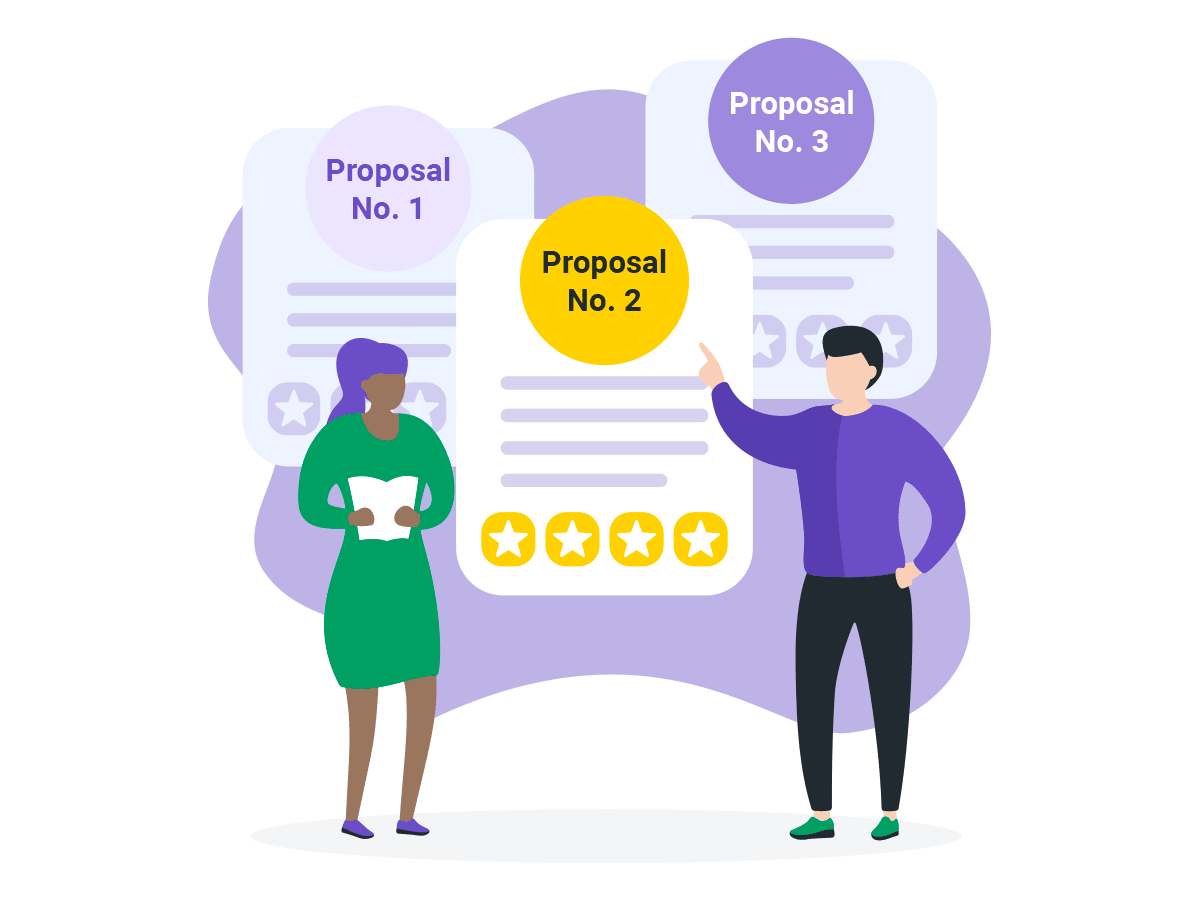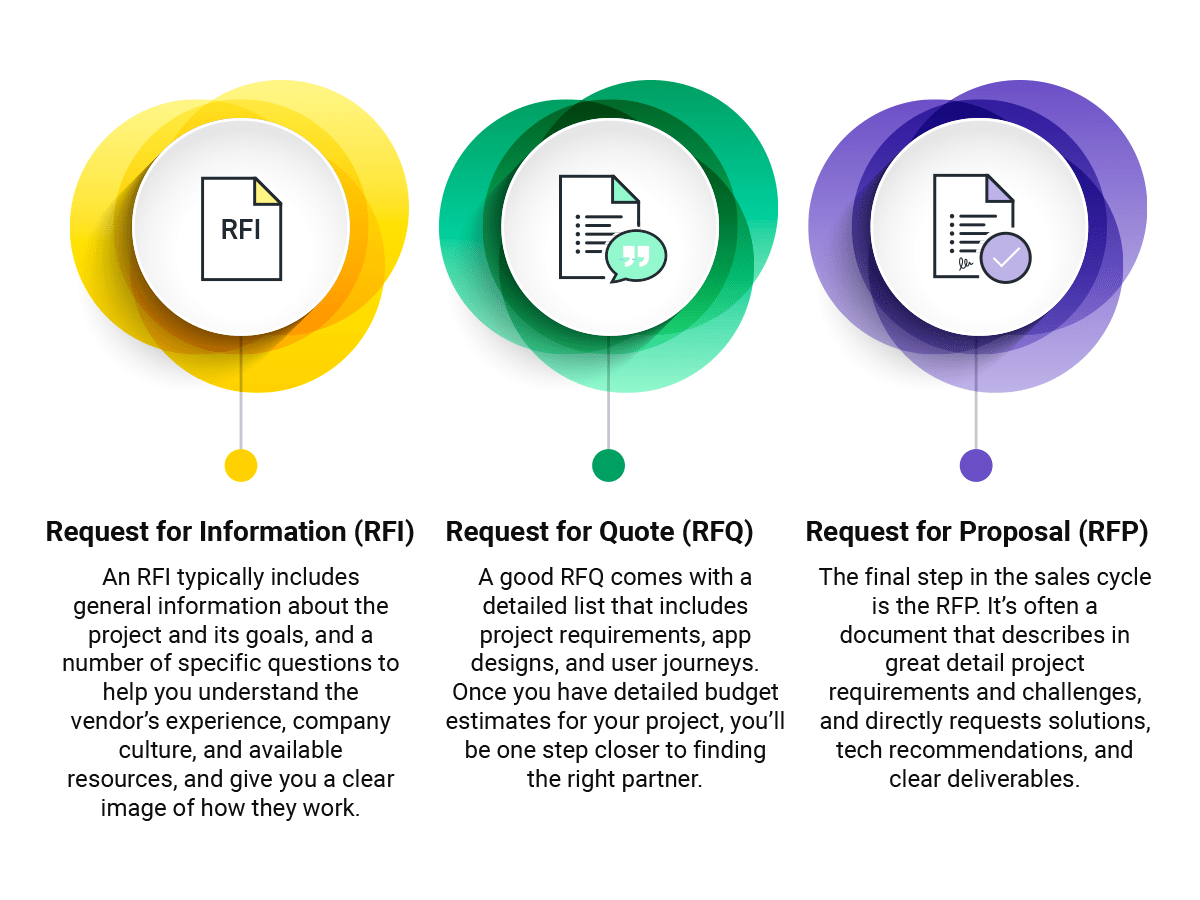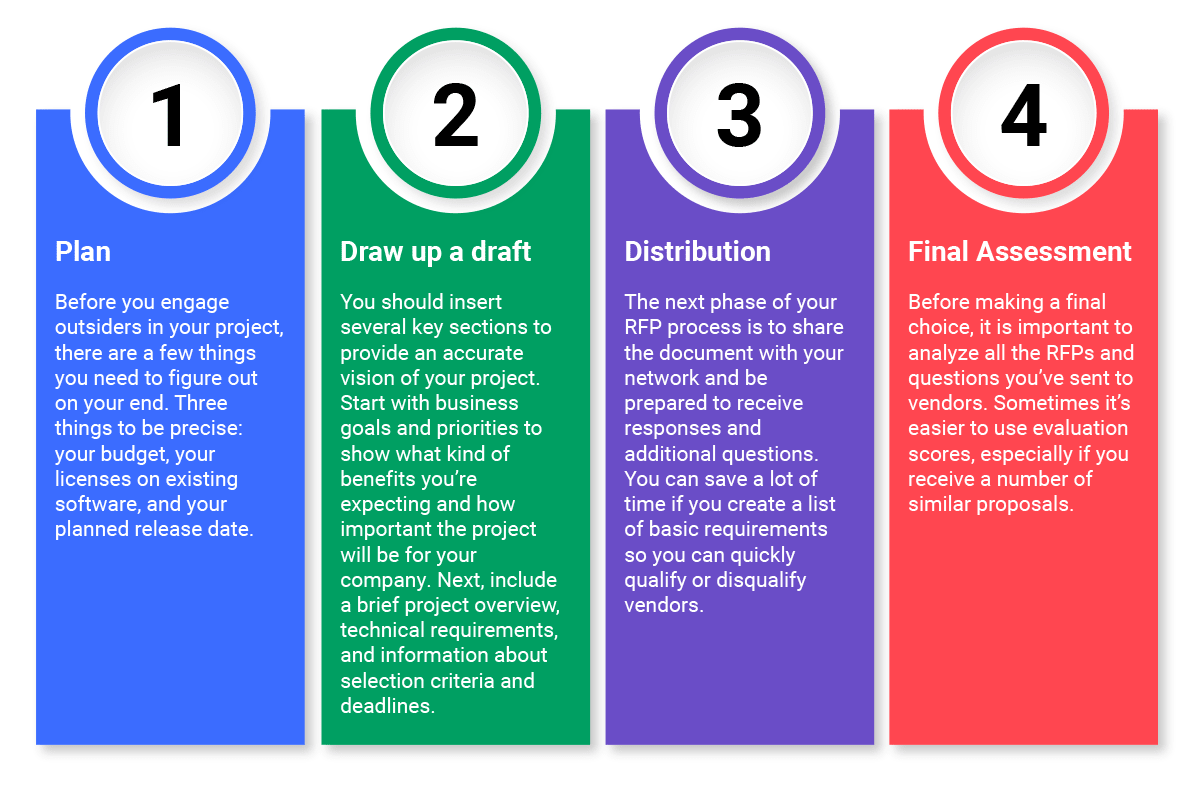One of the most common reasons why software projects fail or don’t get funding are requests for proposals (RFPs) with unclear project requirements. That’s why RFPs play such a crucial role in communicating projects to other vendors.
Writing a structured RFP not only leads to clarity, but also allows companies to understand clients’ needs and provide them with an accurate response.
In this article, we take you through the basics of the request for proposal process and provide guidelines to make well-structured and practical proposals. We also mention other types of documentation, such as RFI and RFQ, and offer a sample outline for your next RFP.

What is an RFP for software development?
A request for proposal (RFP) describes a project in detail so potential software vendors can submit proposals for the development process, technology and so on. Complex software project demand a lot of detailed information, so with an RFP, companies are able to address many product development challenges by collecting ideas from several vendors.
A detailed RFP for software development allows issuers to compare vendor proposals, evaluate different ways to solve a single problem. It also helps save valuable time since one company can send project information to more than one vendor and later compare their approaches.
Companies use an RFP to exchange details about projects and set up partnerships and collaborations. Once a company releases information about a new project, competitive tendering begins, as potential suppliers start proposing their solutions.
The RFP Process: A general outline
Here’s what the process of creating an RFP for software development services looks like:
Write an RFP. Before a company opens its tendering process, there are four things that need to be discussed: business goals, timeframe, budget, technical requirements and specifications. This document is the first step towards understanding what kind of benefits you are expecting and how important the project will be for your company.
Send your RFP to vendors. The next phase of the process is to share the document with a network of vendors and be prepared to receive responses and additional questions.
Find a good match. Before making a final choice, it is important to analyze all the RFPs and any questions raised during the process. Sometimes it’s easier to use evaluation scores, especially if there are a number of similar proposals that make the decision process harder.
The benefits of an RFP for software development
An RFP is beneficial for a variety of reasons, for both issuers and vendors. Since it is often used for large, complex projects, it allows companies to get a number of different solutions, examine them in detail, and decide which would best solve their problem.
Deeper understanding of business outcomes. Although an RFP will take some time to put together, it often provides companies with a better understanding of their product from a business perspective. Once clients understand their project goals, they can successfully communicate it to potential development partners.
“Background information is important as it provides a better understanding of the company and what they want to achieve with their project,” says Lyubomyr Nykyforyk, Solutions Architect at Softjourn.
Saving valuable time. Putting together a detailed RFP saves time in the long run, as it urges teams to discuss all the key points and make necessary decisions regarding the product early on. However, even if a company still doesn’t have all the project information, Softjourn offers consulting services to ensure that there are no information gaps that might mushroom into problems during development.
“We rarely see complete RFPs for software development,“ says Taras Romaniv, Solutions Architect at Softjourn. “However, this doesn’t have to be a roadblock if clients are flexible and ready to work with us to define requirements and specifications on the go. The more information we have, the more we can help.”
Higher accuracy of project estimates. With a standardized RFP for software development, it becomes easier to explain a specific project and receive realistic project estimates. Understanding how many customers a business has, in which stage their product is, or whether the company has come up with an idea and is looking for someone to build it. Overall, the RFP document provides a context that vendors can use to provide a more accurate timeframe, project scope, price range, and use—to generate tailor-made offers.
“Understanding the current position of the company and how their product works are prerequisites for creating an accurate estimate,” says Viktor Levytskyi, Solutions Architect at Softjourn.
The difference between an RFI, RFQ, and RFP
A request for proposal (RFP), request for quote (RFQ), and request for information (RFI) are three distinct documents whose purpose is business communication between a company and potential contractors.

Request for Information
The goal of an RFI is to provide companies with an overview of the vendor’s abilities and resources to help them in the decision-making process. One company can select several vendors and then send them an RFI.
An RFI typically includes general information about the project and its goals, and a number of specific questions to better understand the vendor’s experience, company culture and available resources, and give a clear image of their capacity to provide the necessary services.
Request for Quote
When a company has several vendors shortlisted for a project, the next step is to compare prices. Although price should never be the only criteria for choosing a vendor, it does play a major role in making the decision.
A good RFQ consists of a detailed list that includes project requirements, app designs, user journeys, and detailed budget estimates.
Request for Proposal
The final step in the sales cycle is the request for proposal. It’s a document that describes in great detail project requirements and challenges, and directly requests solutions, tech recommendations, and clear deliverables.
Comparisson table: RFP vs RFI vs RFQ
| Comparing RFP, RFI, and RFQ in Software Development: Purpose, Scope, and Selection Processes | |||
| Criteria | RFP | RFI | RFQ |
| Purpose | To solicit proposals from different vendors for a project, including technical approach, timeline, and cost. | To gather information about potential vendors' capabilities, solutions, and relevant experience. | To obtain price quotes from potential vendors for specific software development services. |
| Scope | Comprehensive, covering project details, tech requirements, proposed solutions, pricing, and evaluation criteria. | Focused on understanding vendors' expertise, technology, and services without necessarily soliciting a full proposal. | Limited to pricing for specific services, often with a predefined set of requirements. |
| Docs | A detailed document outlining project requirements, goals, and submission guidelines. | A document containing questions or topics to help assess the vendor's capabilities and expertise. | A document listing specific services and requesting pricing information from vendors. |
| Vendor Response | A formal proposal that includes technical solutions, project plan, qualifications, and cost estimates. | Informational responses, such as a capability statement, case studies, or product/service descriptions. | A detailed pricing structure for the requested services, including any discounts or special offers. |
| Selection Process | Vendors are evaluated based on their proposals, with a focus on technical expertise, project management capabilities, and cost-effectiveness. | Vendors are shortlisted based on their experience, capabilities, and alignment with the project needs. | Vendors are selected based on the most competitive pricing for the required services. |
| Use Case | When a detailed solution is needed for a complex software development projects with specific requirements. | When initial research is being conducted to identify potential vendors and their capabilities for a project. | When the requirements for services are well-defined, the cost comparison is the main focus. |
RFP structure for software projects
If you were wondering how to write a solid RFP for software development, we’ve got you covered. In general, your RFP document should focus on explaining the most critical aspects of the solutions your company wants to develop and what they should achieve. Let’s take a look at the key sections.
1. Project overview
A brief introduction that includes the current state of the product, whether it's still an idea, a prototype, or a working solution. This part should include a brief explanation of where you are, where you want to be, your business needs, main pain points, and issues that you want to be addressed in the project.
2. Company description and contact
In this section, it's crucial to include basic information about your company, its products or services, and its market position. This section should be as detailed as possible, so that vendors understand how important the solution is for your overall business.
3. Project goals
This is where your company presents a clear picture of its project goals and should include important information, project deliverables, and expectations as to how the product will serve its users. Here you can also include any restrictions and information on your target audience.
4. Technical requirements
A section presenting technical requirements is a useful addition to any RFP document but it is optional.
Once the project starts, clients and vendors will work together on a definition phase to outline hardware and software requirements, as well as other technologies to be used in the project.
5. The project timeframe
Timelines in RFPs for software development are only estimates as they cannot be completely accurate without a huge amount of information. Usually, once your project starts it will be easier to provide a more accurate project schedule.
6. Budget details
The budget range is one of the key aspects of any project and it should include the price range for the entire project.
7. Evaluation criteria and review
These are the criteria that you will use to evaluate whether your project’s needs have been met in a given proposal.
What to remember when writing an RFP
Being precise matters, as it helps avoid potential gaps in the requirements or missing information on integrations. The more information there is in your RFP, the easier it will be for vendors to come back to you with offers.

1. Include all the necessary information
“One of the most common problems we see when analyzing RFPs is that clients only send a list of features without additional information,” says Taras Romaniv. “With a number of different approaches to development, unless the client already has everything planned out, a definition phase is necessary. This ensures that everyone is on the same page so the project can get going.”
Our experts advise you not to mark every feature as a must-have and top priority. Instead, select the few features that will bring the most value. With a sharp focus on what really matters, your project is likely to be successful in addressing the right issues.
2. Understand your needs
Another common issue our experts encounter is clients who are not sure why they need a particular solution. Such requests are based on creating certain solutions without understanding whether they can be applied to solving the client’s problem.
“When a client is oblivious of the problem they are trying to overcome and focuses only on a particular solution, we can’t see the big picture, either,” says Viktor Levytskyi.
3. Structure your ideas
Providing information is instrumental for communicating ideas. However, without a structured approach, your RFP document might seem vague or ambiguous. For that reason, using an outline serves as a worthwhile reminder during the ideation process.
“RFPs can sometimes be misleading, especially when clients want to use similar documents for different projects,” says Lyubomyr Nykyforyk. “When clients don’t have enough information, we can always help them with a definition project and use the output of the project as a basis for further development.”
For clients who don’t have a detailed list of project requirements, the project discovery phase takes them one step closer to understanding what they need to reach their business goals.
The features of a good RFP
There are many different ways to format an RFP for software development, but there’s a common foundation that should be covered.
“A good RFP document has a clear vision of where your company is now and what you want to achieve, so we can have a good understanding of what is needed to get you from one point to the next,” says Lyubomyr Nykyforyk.
A quality RFP is simple, clear and straight to the point. It provides the company description and broad business context. It clearly defines project outcomes, cost and time estimates so that everyone can be on the same page with time restraints and deadlines.
“First, we need to know what the client has and information about it,” says Viktor Levytskyi. “Second, we need to know what the problem is, and third, what the end goal of the project is.”
RFP steps
In the previous sections, we've discussed the importance of RFPs in the software development landscape and how they differ from RFI and RFQ. Now, let's dive into the RFP steps to ensure a systematic and efficient approach to finding the ideal vendor for your project.
In this infographic, we'll break down the key stages of the RFP to help you successfully maneuver through vendor selection and ultimately achieve the desired results for your software development projects and better understand the timeline.

Tips for choosing the right software development company
When choosing the best vendor for your requirements, remember several practical tips.
Here are some important considerations:
- Evaluate potential vendors thoroughly: Carefully research and identify suitable vendors for your project. Look for software development companies with experience with projects similar to yours and a proven track record of success. Check their company background, intellectual property policy, and all the components related to the technical details and project implementation.
- Prepare a thorough document: The RFP should include an executive summary, project overview, project scope, project description, technical details, data security, project management requirements, and quality assurance requirements. Make sure to outline your project's goals and requirements clearly.
- Be realistic with project expectations: Avoid having exorbitant and unreasonable expectations from the software development vendor. Instead, try to set achievable project improvements and targets and establish a rough project plan.
- Involve business analysts and project managers: Make sure to involve both the business development department and the project management team in the process. They can help to identify possible project pitfalls, target audience, technical challenges, and the software development process.
- Focus on communication: Communication is essential in any software development project, so make sure to establish a straightforward communication process with the software vendor. Ask about their project management tools and how they handle communication with clients.
- Consider the testing process: Quality assurance is critical to the success of a software development project. Make sure to ask prospective vendors about their reporting and project management tools, including how they report and handle bugs and issues.
- Including Team Structure and Roles in the RFP. Provide a section that details the required team structure, seniority level, and the roles you expect the vendor to fulfill. In addition, this section should outline the qualifications, expertise, and experience needed for each position, as well as any specific tools or methodologies the team members should be familiar with.
Key roles to consider in a software development team:
- Project Manager: Oversees the project and coordinates communication between the client and the software development team.
- Business Analyst: Gathers and analyzes requirements, translating them into actionable tasks for the development team.
- Software Developers: Responsible for coding, building, and implementing the software solution.
- Quality Assurance (QA) Engineers: Test and validate the software to ensure it meets the requirements and is free of bugs or errors.
- UX/UI Designers: Design the user interface and user experience, ensuring the software is intuitive and visually appealing.
- Technical Writers: Create documentation, user manuals, and other supporting materials for the software solution.
By following these tips, you'll be better equipped to choose a suitable vendor for your software development project and build world-class software that meets your needs. Remember, a successful project relies on a professional IT services provider that can deliver quality software and meet all the requirements.
Sample RFP document download
Final thoughts
A detailed proposal is a great way to gather all your information in one place and save valuable time in the overall process. Another benefit to writing an RFP is its value to the entire process: answering all the relevant questions brings everyone a step closer to a solution and increases the likelihood of future collaboration.
As mentioned, two crucial elements of any RFP are the technical requirements and the scope of work. If they are not detailed enough, vendors will have to make a lot of assumptions, which will influence the accuracy of their offer. To ensure your success, we have made a downloadable template with a detailed breakdown of key aspects of every project.
“Customers need to explain what the drivers are behind the project and WHY they need it,” says Taras Romaniv. “Both customer and vendor should work together on answering WHAT should be developed, and the vendor needs to explain HOW a proposed solution should work.”
Follow our template to accelerate internal discussions related to the RFP process. That way, you will be able to present your ideas comprehensively and quickly find the most compatible vendor able to turn your vision into reality.






